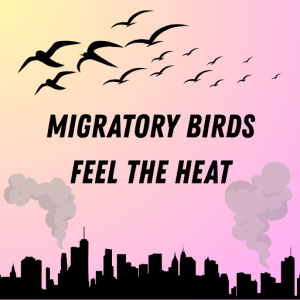Migratory Birds Feel the Heat
By Elizabeth Carroll, C2ST Intern, Loyola University
Upon the long-awaited onset of spring, a thawing Midwest greets millions of migratory birds as they return for the northern hemisphere’s warm season. The soft calls of songbirds and the less pleasant honks of Canada Geese replace our alarm clocks as a reminder of the warm weather to come. But a bird’s migration is no small task, even for the toughest and most resilient species. Traveling from wintering grounds to breeding grounds can be a several thousand mile journey teeming with a wide variety of predators, perilous weather, and unpredictable resource availability. Threats of climate change throughout their migration routes amplify birds’ vulnerability to these dangers.

We see the highest density of migratory birds passing through Chicago around May 9th-14th, though the exact timing of migration depends on each species’ preferred habitats and nutritional needs. Waterfowl like ducks and geese get an early start on migration as soon as late February,
when lakes begin to thaw, while songbirds like warblers may hold off until late April to keep their smaller bodies warm for as long as possible.
The timing and success of bird migration are uniquely complicated by the consequences of a changing climate. Professor Stephen Mitten, Loyola University Chicago’s resident bird specialist, has noted a change in the amount and types of migratory birds he has observed throughout his 14 years in Chicago. “Each year, it appears that more western and southern birds are showing up here,” he states, describing sightings of Mountain Bluebirds and Neotropical Cormorants across Illinois. These species are expanding their ranges to follow the warming temperature patterns in the Midwest.
Successful spring migration and subsequent breeding begins with a high quality, resource-lavish winter home. The abundance of food and native vegetation in wintering grounds are metrics that scientists consider to be the most influential over migration success, but a 2024 study has found that increasingly dry conditions in the southern hemisphere are having lethal effects on birds during and following their migration. The Caribbean, a historically lush and attractive winter home for many migratory birds, has suffered droughts that have been slowing the productivity of their natural environments since the 1950s. Low environmental productivity is reflected in these habitats’ lack of available food, minimal vegetation for perching or foraging, and generally poor quality for birds.
Professor Mitten witnessed the degradation of wintering grounds for shorebirds first-hand while living in Belize for eight years. “I did research in 2004 for the Smithsonian on Twin Cayes, a mangrove covered caye [key] of about 72 hectares,” he recalls, “it is about half that size now.” Rising sea levels are flooding Central American countries and eroding away the preferred homes of island birds. During a recent visit to South America, Professor Mitten noted the flooding was profound enough to drastically affect humans too: “I was astonished that the whole town of Bolpebra, on the Acres River in Bolivia, had to be relocated to higher ground because of increased flooding.” Humans can adapt to climate change by moving their homes, but it is not so simple for birds.
Biological and physical changes in birds have been observed by Professor Mitten and other birders in response to climate change, reflecting birds’ notable adaptability to alterations in their environment across short periods of time. Shifts in phenology, or the timing of ecological events within a season, have been the most conspicuous among these changes. In birds, migration phenology is usually associated with the changing day lengths we see between seasons. Decreasing daylight in southern wintering grounds indicates that it is time to start moving north, where plants are blooming and insects are abundant. But what happens when these birds get to their breeding grounds and these resources aren’t there?
Birds are beginning to arrive earlier and leave later from their springtime homes due to climate change, causing a mismatch between their arrival and the presence of food sources in these northern environments. Insects, however, are genetically programmed to emerge at the same time every year. This means the premium protein source for many bird species is still underground while birds are recovering from their migration and trying to breed, which is another energetically expensive task. This lack of food directly decreases birds’ survival and reproductive success during the spring.
Many birds have an impressive ability to adjust their migration and breeding phenologies to match the timing of spring green-up. This is advantageous when it comes to surviving climate change, but not all species are equally adaptable. Professor Mitten identifies flexibility in behaviors like diet, breeding times, and habitat preferences as one characteristic that will make birds more resilient in the face of climate change. “A species that can switch from eating insects to fruits or seeds may have an advantage,” he explains, referring to the mismatch between insect emergence and birds’ arrival in the north. Some physical traits are accumulating in migratory bird populations to help them mitigate the stress of climate change as well. Smaller bodies and longer wings, Professor Mitten notes, are becoming more favorable characteristics to help birds dissipate heat more efficiently.
Birds fill a myriad of roles in all of Earth’s ecosystems, as efficient pollinators, pest controllers, and even decomposers. Threats to birds’ welfare are threats to our own welfare, and declining populations necessitate action against climate change. Although birds are some of the most widely studied organisms in the world, there is still much to learn about the immediate impacts of climate change on these magnificent creatures — and what we can do to help them.
To learn more about the future of Illinois birds in the face of climate change, click here.
Resources
- https://www.nature.com/articles/s41598-017-02045-z
- https://www.sciencedirect.com/science/article/pii/S0960982224012259?via%3Dihub
- https://www.sciencedaily.com/releases/2023/09/230922110806.htm
- https://www.nwf.org/Magazines/National-Wildlife/2010/Migration-timing
- https://besjournals.onlinelibrary.wiley.com/doi/full/10.1111/2041-210X.14052
- https://www.birds.cornell.edu/home/bring-birds-back/